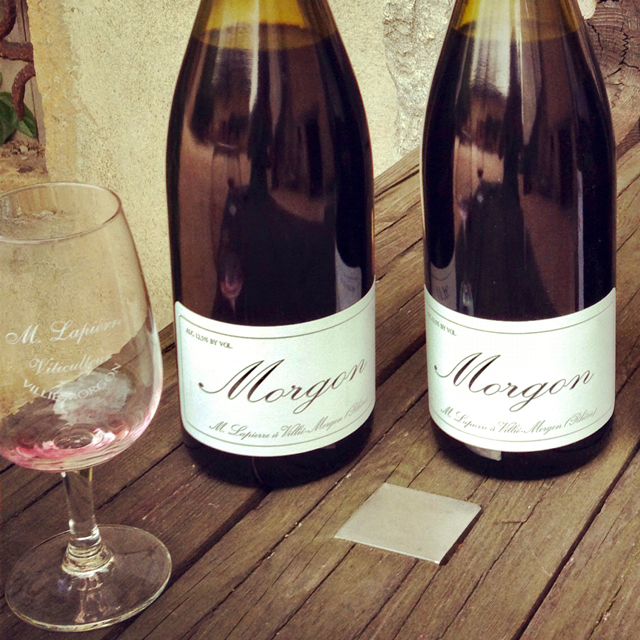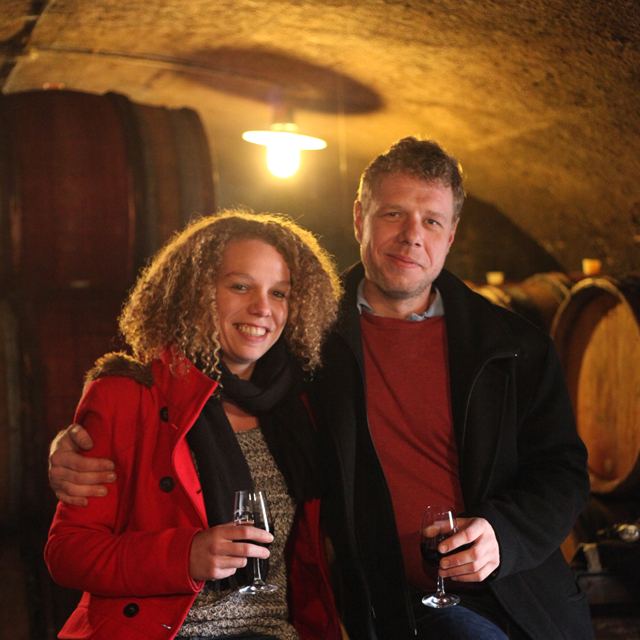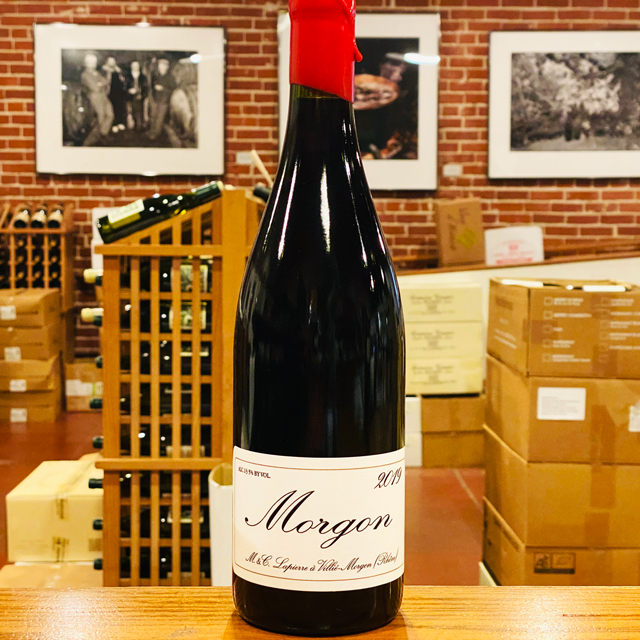Notify me
2019 Morgon “N”
M. & C. Lapierre

Camille and Mathieu Lapierre

The domaine’s flagship bottling, crafted from vines averaging sixty years old from a variety of sites across the Morgon appellation. Inviting aromatics, succulent flesh, juicy finish. Bottled with no added sulfur.
—Anthony Lynch
| Wine Type: | red |
| Vintage: | 2019 |
| Bottle Size: | 750mL |
| Blend: | Gamay |
| Appellation: | Morgon |
| Country: | France |
| Region: | Beaujolais |
| Producer: | M. & C. Lapierre |
| Winemaker: | Mathieu & Camille Lapierre |
| Vineyard: | 60 yrs, 10 ha |
| Soil: | Granitic Gravel |
| Aging: | Wines aged on fine lees in old Burgundy barrels |
| Farming: | Organic (certified) |
| Alcohol: | 14% |
More from this Producer or Region

2022 Morgon “La Roche Pilée”
France | Beaujolais
The newest addition to the Thévenets’ Morgons, La Roche Pilée is lush and light at the same time, with a balance of soft minerality referenced in the name (which means crushed rock).

2022 Morgon “Vieilles Vignes”
France | Beaujolais
Leave it to Breton to take summer heat and turn it into a light summer breeze in a glass.

2022 Beaujolais Blanc “Clos de Rochebonne”
France | Beaujolais
Different from the whites of neighboring Mâcon, this blanc is firm but also a touch fleshy.

2023 Vin de France Rouge “Raisins Gaulois”
France | Beaujolais
This juicy red—loaded with bright, playful fruit—is low in alcohol and delightfully refreshing.

2022 Fleurie
France | Beaujolais
An opulent, mouth-filling expression of granitic terroir, this bottling has the delicate floral nuances and fine-grained tannin that differentiates Fleurie from the other crus.

2021 Brouilly “Reverdon”
France | Beaujolais
The 2021 vintage proved an elegant one for Thivin’s Brouilly, with all the suppleness and tonicity you’d expect from this storied estate.

2021 Morgon “Charmes - Infusion”
France | Beaujolais
This classic, cool-weather vintage of Quentin Harel’s one hectare holding in Morgon spends three months macerating in concrete amphora. The result is a distinct softening of its crunchy, mineral-laced bramble.

2022 Côte de Brouilly
France | Beaujolais
Not your basic Beaujolais, it showcases pedigreed and assertive fruit that is strikingly substantial for Gamay.

2021 Juliénas “Beauvernay”
France | Beaujolais
An electric lightning bolt of Gamay from a steep, windy hillside.

2022 Morgon
France | Beaujolais
Silky and perfumed, with no rough edges, this is dangerously swallowable.
About The Producer
M. & C. Lapierre
Little would we know that when Marcel Lapierre took over the family domaine from his father in 1973, he was on the road to becoming a legend. Following the example of traditionalist Jules Chauvet, Marcel and three other local vignerons Jean Foillard, Jean-Paul Thévenet, and Guy Breton, soon hoisted the flag of Chauvet’s back-to-nature movement. Kermit dubbed this clan the Gang of Four, and the name has stuck ever since. The Gang called for a return to the old practices of viticulture and vinification. Sadly, the 2010 vintage was Marcel’s last. His children, Mathieu and Camille continue the great work that their father pioneered, introducing biodynamic vineyard practices and ensuring that Marcel's legacy lives on.
About The Region
Beaujolais

After years of the region’s reputation being co-opted by mass-produced Beaujolais Nouveau and the prevalence of industrial farming, the fortunes of vignerons from the Beaujolais have been on the rise in the past couple of decades. Much of this change is due to Jules Chauvet, a prominent Beaujolais producer who Kermit worked with in the 1980s and arguably the father of the natural wine movement, who advocated not using herbicides or pesticides in vineyards, not chaptalizing, fermenting with ambient yeasts, and vinifying without SO2. Chief among Chauvet’s followers was Marcel Lapierre and his three friends, Jean Foillard, Guy Breton, and Jean-Paul Thévenet—a group of Morgon producers who Kermit dubbed “the Gang of Four.” The espousal of Chauvet’s methods led to a dramatic change in quality of wines from Beaujolais and with that an increased interest and appreciation for the AOC crus, Villages, and regular Beaujolais bottlings.
The crus of Beaujolais are interpreted through the Gamay grape and each illuminate the variety of great terroirs available in the region. Distinguishing itself from the clay and limestone of Burgundy, Beaujolais soils are predominantly decomposed granite, with pockets of blue volcanic rock. The primary vinification method is carbonic maceration, where grapes are not crushed, but instead whole clusters are placed in a tank, thus allowing fermentation to take place inside each grape berry.
Much like the easy-going and friendly nature of many Beaujolais vignerons, the wines too have a lively and easy-drinking spirit. They are versatile at table but make particularly good matches with the local pork sausages and charcuterie. Though often considered a wine that must be drunk young, many of the top crus offer great aging potential.
More from Beaujolais or France
2022 Beaujolais MAGNUM
Domaine Dupeuble France | Beaujolais
2022 Brouilly “Reverdon”
Château Thivin France | Beaujolais
2022 Côte de Brouilly “Cuvée Zaccharie”
Château Thivin France | Beaujolais
2021 Régnié “Grain & Granit”
Jean-Paul et Charly Thévenet France | Beaujolais
2022 Morgon
M. & C. Lapierre France | Beaujolais
2021 Morgon “Vieilles Vignes”
Jean-Paul et Charly Thévenet France | Beaujolais
2022 Moulin-à-Vent “Vieilles Vignes”
Bernard Diochon France | Beaujolais
2021 Morgon “Eponym”
Jean Foillard France | Beaujolais
2021 Chiroubles “Cuvée Léa”
Guy Breton France | Beaujolais
2022 Régnié “En Voiture Simone”
Jean-Paul et Charly Thévenet France | Beaujolais
2021 Côte de Brouilly HALF BOTTLE
Château Thivin France | Beaujolais
2022 Beaujolais
Domaine Dupeuble France | Beaujolais
2022 Beaujolais MAGNUM
Domaine Dupeuble France | Beaujolais
2022 Brouilly “Reverdon”
Château Thivin France | Beaujolais
2022 Côte de Brouilly “Cuvée Zaccharie”
Château Thivin France | Beaujolais
2021 Régnié “Grain & Granit”
Jean-Paul et Charly Thévenet France | Beaujolais
2022 Morgon
M. & C. Lapierre France | Beaujolais
2021 Morgon “Vieilles Vignes”
Jean-Paul et Charly Thévenet France | Beaujolais
2022 Moulin-à-Vent “Vieilles Vignes”
Bernard Diochon France | Beaujolais
2021 Morgon “Eponym”
Jean Foillard France | Beaujolais
2021 Chiroubles “Cuvée Léa”
Guy Breton France | Beaujolais
2022 Régnié “En Voiture Simone”
Jean-Paul et Charly Thévenet France | Beaujolais
2021 Côte de Brouilly HALF BOTTLE
Château Thivin France | Beaujolais
2022 Beaujolais
Domaine Dupeuble France | Beaujolais
Where the newsletter started

Where the newsletter started
Every three or four months I would send my clients a cheaply made list of my inventory, but it began to dawn on me that business did not pick up afterwards. It occurred to me that my clientele might not know what Château Grillet is, either. One month in 1974 I had an especially esoteric collection of wines arriving, so I decided to put a short explanation about each wine into my price list, to try and let my clients know what to expect when they uncorked a bottle. The day after I mailed that brochure, people showed up at the shop, and that is how these little propaganda pieces for fine wine were born.—Kermit Lynch
















